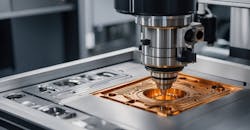As finished products and component parts become smaller in line with design standards, and quality standards rise – precision manufacturing capabilities are becoming increasingly critical to machining operations. And while there are various ways to achieve that precision, adopting a micromachining process may be a good strategy for machinists aiming to fulfill those new standards.
“Micromachining” applies computer numerical control (CNC) machining on the microscale. In an engineering context, that generally means dealing with dimensions between 1 and 500 micrometers (µm).
Machining on that scale requires specialized equipment. A micrometer is not visible to the naked eye and conventional CNC tools are too large to support that level of precision. However, newer tooling ends and automation make it possible to perform micromachining reliably.
And the equipment necessary for this kind of production is becoming increasingly accessible as the demand grows and developers and manufacturers add to their portfolios. While some manufacturers may hesitate to adopt micromachining systems, those that have done record several important advantages.
Benefits of the micromachining
Understanding how micromachining technology can improve your workflow is the first step to implementing it effectively. Here are some of the most important advantages of the process.
Higher precision. The most obvious advantage of micromachining processes is that they are far more precise than conventional CNC milling. Standard machining tolerances hover around 0.005 inches, more than 120 µm. A micro-capable mill will have a much lower tolerance, as it needs to cut on the microscale with high repeatability.
That higher precision is beneficial for a few reasons. It lets the programmer and operator execute much smaller products. That’s particularly advantageous for electronics producers amid ever-increasing demand for smaller components. Similarly, higher precision enables lets the operator cut more complex designs.
Fewer errors. Micromachining’s precision also means production errors are reduced. CNC milling is already fairly error-resistant, as CNC spindles produce less vibration than other machining methods. Applying that advantage on a smaller scale makes you even less likely to damage the material you cut.
Because micro-capable CNC machines remove less material at once, it’s harder to over-machine anything. Their size also means less resistance and less power, which further reduces vibrations and heat to preserve your material’s structural integrity.
Material versatility. A less obvious benefit of micromachining processes is that they can work with a greater range of materials. This versatility stems from the fact that it’s a less intense process than conventional CNC machining.
"Macro" CNC mills may spin too fast, remove too much material, produce too much torque, or get too hot to work with some delicate materials. Micromachining’s smaller form factor mitigates these concerns. Consequently, it’s possible micromachine even the most brittle metals, plastics, and ceramics.
Energy efficiency. Micromachining is also more energy-efficient than conventional alternatives. Smaller tools naturally require less power to move. Removing less material in a pass also reduces friction and resistance, further minimizing energy consumption.
This efficiency has two main advantages: First, it reduces ongoing expenses by minimizing electricity consumption. Secondly, it makes manufacturing processes more sustainable, which is an increasingly important factor for manufacturers and their customers.
Less waste. Similarly, micromachining processes produce less waste. One of the few downsides of CNC machining is that it’s more wasteful than other methods because it removes material instead of shaping or adding it. Using a smaller, more precise scale minimizes that waste.
Smaller cutting allowances ensure you’ll get the exact proportions you require without removing extra material. The precision also will prevent material loss from mistakes.
When, how to apply micromachining
It’s hard to miss the potential of micromachining for precision manufacturing. Still, these small-scale processes aren’t ideal for every situation. Making the most of this technology is just as much about knowing when not to use it as knowing when it’s best.
Micromachining processes are best suited for complex or small-scale jobs. While they can perform larger tasks with higher precision, that accuracy comes at the price of efficiency at a certain point. Removing more material with a smaller mill will take longer, so opt for conventional machining when working with simple designs or larger components.
Because micromachining uses specialized equipment, it also requires special training. The manufacturing sector could be short 2.1 million jobs by 2030, so filling that talent gap could be difficult. Consequently, shops with smaller workforces may find it more economical to outsource micromachining tasks instead of buying and using this equipment in-house.
Micromachining can also be expensive. The resulting savings will make up for those costs over time if you use this equipment enough, but not every facility will. Precision-focused manufacturers — like those making electronics or medical devices — will benefit more from performing this work in-house, but more general-purpose companies may find outsourcing more effective.
Micromachining offers several key advantages for precision manufacturing. Understanding these benefits and how they apply will help you make the most informed decision about implementing micromachining processes.
Some manufacturers profit from micromachining more than others, but these benefits apply to many use cases today. Determine your needs and compare them to these advantages and applications to make the best decision.
Emily Newton is the Editor-in-Chief of Revolutionized, an online magazine exploring the latest industrial innovations.
About the Author
Emily Newton
Emily Newton is the Editor-in-Chief of Revolutionized, an online magazine exploring the latest industrial innovations.
